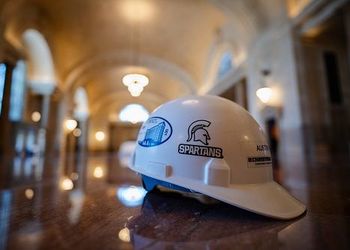Faculty Voices

Danita Brandt: A story of fire, water and ice
If you are like most people, you probably take for granted the earth beneath your feet. After all, it’s just boring rocks and dirt, right? I have 372 words remaining in which to encourage you to look more closely at the landscape and rocks around us, because every rock tells a story.
Michigan’s geologic story is one for the textbooks, because few other states have a geologic history as long and varied as Michigan’s. Our story begins a mind-bending 3 billion years ago, in what is now Michigan’s Upper Peninsula. We would not recognize the place — collision of tectonic plates in the Iron Country triggered volcanic eruptions and mountain building. Ancient pillow basalts from these volcanoes—like those forming on the seafloor off the coast of Hawaii today—can be seen in Marquette. Michigan’s
Iron ore, later to become the backbone of our auto industry, was a product of those tectonic upheavals.
A billion years later, the area we know as the Keweenaw Peninsula was the site of tectonic plates pulling apart, or rifting. The magma that welled up from Earth’s interior along the fractures generated by rifting was rich in copper, the mineral that would define the economy of our state eons after the last tectonic plate ground to a halt. Flash forward 2 billion years, and we see Michigan covered by a shallow, tropical sea.
How do we know? Our state icon, the Petoskey stone, is a fossil coral, a denizen of that long-vanished sea, along with other marine invertebrates like clams, snails, and the extinct trilobites. Detroit’s salt and Grand Rapids’ gypsum formed in this shallow sea. Over the millennia, billions of microscopic plankton accumulated on the sea floor, forming petroleum-rich shale that we now tap to fuel our cars.
As the sea drained away from Michigan, ferns and other plants grew near coastal swamps, eventually to become the coal beds of Fitzgerald Park in Grand Ledge. In the last chapter of our story, geologically “only yesterday,” glaciers waxed and waned, leaving rocks and boulders imported from Canada as their calling cards, including “The Rock” at MSU. Glaciers sculpted our modern landscape and gave “The
Mitten State” our identity— they deepened and widened ancient river valleys to form the Great Lakes.
The story of how Michigan was born of fire, water and ice is hardly boring ! And it’s written in the rocks under our feet.
Reprinted with permission from the Lansing State Journal.
Danita Brandt is an associate professor in MSU’s department of geological sciences.
She loves sharing Michigan’s geologic story through teaching, research and outreach activities, including Darwin Discovery Day and MSU Science Festival.



